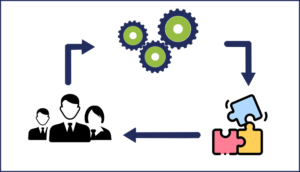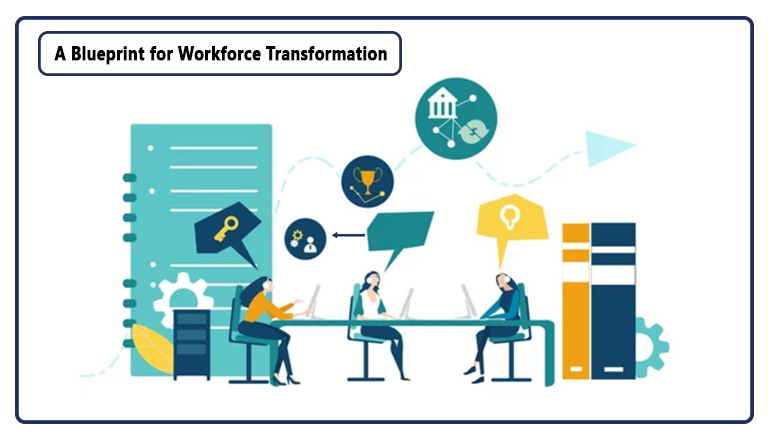The rapid evolution of technologies, demographic shifts, and ever-changing macroenvironmental factors are giving rise to a multitude of disruptions that are changing the way we work. In response to these shifts, organizations need to equip their people with the tools and skills necessary to navigate this evolving landscape.
But how do organizations go about doing that? The process is called workforce transformation. And, in this article, we’ll take you through what workforce transformation means, the transformation imperative, and how you can help your organization transform successfully.

What is Workforce Transformation?
Workforce transformation is the process by which organizations change their processes, tools, technologies, and skills to make sure their workforce is ready for the future of work. As a result, workforce transformation usually is divided into several areas of focus.
1. Organization Transformation
This is the transformation strategy targeting the re-design of the organizational structure, job roles, and relationships to ensure the organization is ready for the future. A Deloitte study shows that only 21% of employees and executives believe that the traditional organization structure and job roles are effective in organizing work that creates value. To meet the demands of the upcoming decade, structures that support broadened and fractionalized work are more capable of adapting fast, leveraging employee skills, and providing a better employee experience.
2. Leadership Transformation
The leadership skills of the past decade are not going to cut it for the future. Moving away from leadership that is based on position, titles, authority, and number of direct reports, the leaders of the future can come from any role in the organization. They are simply individuals who can use insight, action, and personal accountability to influence others and mobilize work to create and capture organizational value. With this changing definition of leadership, any workforce transformation strategy must include a plan to build a new culture of leadership that builds leadership skills at all levels of the organization.
3. Digital Transformation
The upcoming decade will be defined by a reshaping of jobs driven by the rise of automation and artificial intelligence (AI). New jobs will be created, some jobs will be changed, and other jobs will go obsolete. In fact, although there’s no conclusive economic study, it is estimated that AI could take the jobs of as many as one billion people globally and make 375 million jobs obsolete over the next decade. With that in mind, organizations need to assess their current work processes and talent to identify what changes will inevitably occur and to equip their employees with the necessary digital skills to capitalize on the evolution of AI and re-skill to stay of value to their organizations.
4. Cultural Transformation
Traditional hierarchical decision-making, top-down command and control, and office-based work cultures will drive top talent away and reduce the speed to respond to market changes. The workforce now expects empowerment, flexibility, agility, and a focus on well-being. Organizations will need to embark on cultural transformation journeys to rebuild the cultures of their organizations around these pillars and promote work environments that support them.
5. Business Process Transformation
As technologies evolve and AI infiltrates many aspects of work, and to support skill-based roles and structures, organizations may need to re-design business processes. This usually involves an assessment of current processes, a mapping of the most optimal processes leveraging technologies and people, and a plan to re-skill people to follow these new processes. An excellent success story of such a transformation was made by L’Oreal, the world’s leading cosmetics company, as they implemented agile production lines so that some of their factories could shift between a range of 20 different products in under 20 minutes — a process which used to take them over four hours in the past. And all that could not have happened without leveraging technology and ensuring employees were re-skilled to use it.

Process for Workforce Transformation
Workforce transformation is not a one-year hit-and-run activity. In fact, it is a long process that may span 3-5 years and requires huge investments of time, money, and effort. Ensure you fully understand what it takes before you embark on your workforce transformation journey. Here is how you can approach transforming your workforce, based on PwC’s model of workforce transformation.
1. Start with one or two business outcomes
There are many factors affecting workforce transformation, so you may be tempted to change everything at once. But if you aim at achieving many goals, you will achieve none. Instead, assess the situation and identify the top one or two business outcomes that will create the biggest impact when adapting to the new face of work. Then, map out the ideal work processes, workflows, and technologies that can help you achieve these outcomes. Be very specific about what metrics will be used to measure these outcomes’ achievement.
2. Assess your workforce’s skills
Start out with a skills inventory. What skills do your employees currently possess? Be wary of trusting job positions, experience, and degrees. Instead, utilize assessments, performance reviews, AI-driven tools, training data, and self-reporting to know more about the wide array of skills your employees have. You never know if an employee with amazing graphic design skills may be working in an accountancy role in the finance department or if an employee with excellent presentation skills could be working in a back-end role.
3. Develop re-skilling and up-skilling plans
Based on your assessment of your employees’ current skills and your understanding of the future skills your outcomes’ achievement requires, identify what skills you will hire for and what you will simply re-skill for. When it comes to re-skilling, as with all other initiatives, start with the high-impact roles first — the roles that will have the greatest impact on your goals’ achievement. Eventually, the entire organization will be re-skilled but start small first.
4. Build emotional commitment
For workforce transformation to succeed, you must have your leaders and employees on board. To gain buy-in, ensure that the benefits of the transformation are widely and clearly communicated. Understand that transformation usually heightens employees’ anxiety as they wonder about the future of their roles in the ‘new organization’. Build your communication around the focus on re-skilling to make everyone part of the change and communicate the vision of the new organization with excitement and optimism. If the top leaders in your organization themselves can take upskilling programs and communicate their learning successes widely, they are likely to inspire confidence and enthusiasm in employees.
Also, identify the employees in your organization who are the most ready to change. These are your ‘champions’. Help them re-skill fast and challenge them with projects that help achieve your top transformation business outcomes. Ensure you communicate their success stories across the organization to build hype and excitement.
5. Assess your outcome achievement
Keep track of your metrics regularly and be flexible to change plans and adjust. A transformation journey is a long ride and is one that is full of uncertainty. So, don’t be discouraged when you experience failures or when it takes time before you can realize a significant return on the investment.
Transform Your Workforce Now
Now, that you know what workforce transformation is and the best practices to implement a workforce transformation journey, you may be considering if your organization needs one. If you’re interested in receiving expert help on the topic, you can contact us here.

